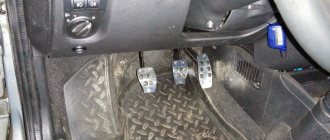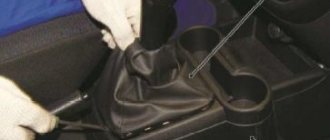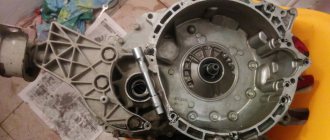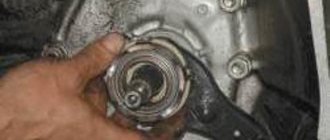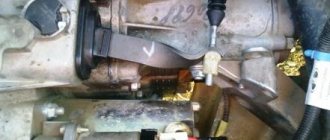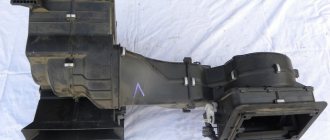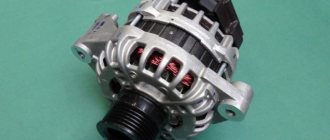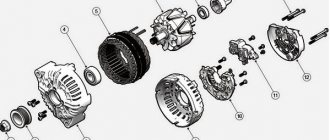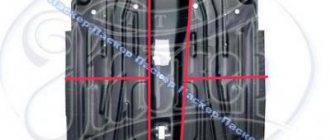Lada Granta is a car that uses a single-plate closed clutch mechanism. Despite its simplicity, it is quite technologically advanced, equipped with elements that dampen vibrations during shifting, reduce wear, and simplify gear shifting.
The main difference between the Granta clutch and many previous models is the absence of gaps between the release bearings, as well as the placement of the spring legs inside special casings, which increases the protection factor from external loads.
Despite this, the part is subject to wear, and sooner or later there will be a need to replace it. You can perform this operation on your own.
Preparatory stage before replacing the clutch on the Lada Grant
Necessary tools, materials:
- set of car keys, sockets, ratchet;
- extension;
- calipers;
- additional lighting;
- screwdrivers with a set of bits;
- mounting blade;
- pliers;
- hammer;
- metal brush;
- hydraulic (mechanical) jack;
- cylinder and torque wrench;
- graphite-based lubricant “CV joint-4”;
- container for draining waste;
- 6 liters of gear oil;
- clutch assembly;
- wooden spacers;
- rags.
When should adaptation be made?
Adaptation of AMT should be done in the following situations:
You have a pre-production car, and you need to update the settings to more recent and correct ones.
The fact remains that the first cars turned out to be a little damp and there’s nowhere without it, but fortunately AvtoVAZ quickly solves the problem, as it has already done with bushings and stabilizer struts, with the clutch.
When replacing the clutch
It turned out that the Turkish Valeo clutch, which was installed on the first cars, is not suitable for the weight of the car. As a result, the owners of the first West felt the clutch slipping, felt that the car was moving poorly and needed to increase the speed. When replacing the clutch with a new one, adaptation is carried out. If for some reason you changed the clutch not from an official dealer but on your own, do not be afraid to move on the new clutch without adaptation as necessary. But it will need to be done.
Every 15,000 km
AvtoVAZ recommends adapting the robot’s clutch as it wears out, i.e. every 15 t.km for correct and resourceful operation.
Sequence of actions when removing and replacing the Lada Granta clutch with cable drive
- After removing the manual transmission (the process is described above), we mark the location of the basket and flywheel with marks. In the event that we do not plan to replace the basket or pressure plate. The decision is made by the repairman based on the diagnostic results.
Removed manual transmission
- Unscrew the bolts and remove the basket with the pressure driven disk.
Cart with disc
Note to the driver!!! We loosen the tightening of the bolts evenly, according to the diagonal principle, one turn of the key.
- Remove the discs from the clutch basket.
Removing a disc from the bin
- We carry out troubleshooting of parts, adjacent mechanisms and elements.
What to pay attention to when troubleshooting:
- cracks, breaks in parts;
- depressions of more than 0.2 mm;
- check for cracks on the diaphragm spring;
- We inspect the support rings; there should be no signs of wear, visible or obvious defects on them;
We replace worn elements with new ones as necessary.
Do-it-yourself clutch installation on a Lada Granta
- Using a mandrel, we install the driven disk, basket, and centering pins.
- We fix the basket to the flywheel with three bolts. We tighten the bolts evenly according to the diagonal principle with a force of 37 N.m. We use a torque wrench.
- We remove the frame and install the manual transmission.
- We fix the clutch drive on the manual transmission.
- We adjust the distance from the plastic bushing to the drive fork. It should be equal to 27 mm. We adjust the key value to “10”.
Related link:
Lada Granta automatic: owner reviews
We measure 10 mm
Where is the cable clutch mechanism of the Lada Granta?
In cars of the Lada Granta family, the clutch is installed under the flywheel housing at the junction of the engine and the manual transmission housing. To carry out maintenance work, it is necessary to completely/partially dismantle the transmission.
How to check the release bearing on Kalina and how malfunctions manifest themselves (noisy or buzzing)
To understand whether your Kalina needs to replace the clutch, you must first react in time to signs of failure and diagnose the unit. Signs of a faulty Kalina release bearing:
- Noise or hum when pressing the pedal (damaged, insufficient lubrication or jammed);
- Difficulty pressing the pedal occurs when the coupling ear is broken, as well as the spring is deformed;
- These videos clearly show when the Kalina release bearing is faulty (noise, buzzing, knocking, creaking), as well as how to check the release bearing.
How to remove the release bearing from a Lada Kalina - location of the part and gearbox mounting diagram
As mentioned at the beginning of the article, to correctly replace the VP and dismantle it, you will need to remove the gearbox. Below is a photo of the transmission from below. To dismantle the manual transmission, you will need to disconnect all the components under the hood that are attached to it. Next, the wheel drives and front suspension elements are removed. Then the manual transmission is unscrewed from the “engine” and removed. Inside the “head” of the clutch housing is the release bearing itself.
Signs of clutch wear
| Sign | Cause and remedy |
| Incomplete engagement of the clutch (slips) | Replacing discs, cleaning clutches |
| Incomplete shutdown (leading) | Prevention of the clutch mechanism |
| Periodic jerks | Clutch cable wear, clutch replacement |
| Vibration, beating when shifting to higher gears | The flywheel is bent, the gripper teeth are worn out. Replacing the flywheel and related consumables |
| Noise, creaking, grinding noise when activated | Damper spring wear, replacement with a new one, drive lubrication |
| Pedal free play is increased, exceeding 2 -3 mm | Tensioning the cable, replacing with a new one |
| You can hear the smell of burnt friction linings | Dismantling the clutch block, replacing worn elements |
| Increased fuel consumption | Flywheel worn, teeth damaged |
| Reduced acceleration dynamics | Replacing clutches |
Selecting a new part
It is difficult to determine the exact life of the clutch mechanism on the Grant; too much depends on the operating conditions. Attentive drivers who know how to change gears, change technical fluids in a timely manner, and drive without slipping can easily use the clutch for 100 thousand kilometers. The best replacement solution is LUK mechanisms.
Review of Manufacturer Prices
| Manufacturer article number | Price, rub.) | Resource (Thousand km) |
| Set of wheels LADA 2190-316010001 | From 3100 | 85 — 105 |
| —/— 2190-31601000 | —/— | —/— |
| —/— 302050901 | —/— | —/— |
| —/— 302052223 | —/— | —/— |
| —/— 302052307 | —/— | —/— |
| LADA 21810160118001 clutch | From 650 | 80 |
| LADA 21090160119000 input shaft guide | From 750 | 75 — 80 |
| LADA 21010160121500 fork support | From 150 | 75 – 95 |
| LADA 21810160120001 plug | From 800 | 85 – 95 |
| Connecting spring fork and clutch 21010160118800 | From 350 | 85 — 95 |
*prices are current as of October 30, 2018.
Recommendations for the selection of parts and components
The vast majority of spare parts are provided by domestic manufacturers. Foreign analogues are 10-17% more expensive. The manufacturing quality of the parts is approximately at the same level.
In order to prevent the purchase of counterfeits, use the services of official representative offices, dealer centers, and authorized service stations.
Lately, ordering parts with their subsequent installation directly in workshops has become popular. The advantages of this choice are professional installation, prompt delivery, and a guarantee.
Lada Granta clutch diagram
List of online stores selling parts (Moscow, St. Petersburg, Kyiv regions)
| № | Name | Address |
| 1. | "VIN code" | VIN-code.rf/ |
| 2. | "Avtopiter" | https://www.autopiter.ru/ |
| 3. | "DvizhCom" | https://dvizhcom.ru/ |
| 4. | "BaltKam" | https://www.baltkam.ru/ |
| 5. | "Elite" | https://eshop.elit.ua/ |
| 6. | "Clan" | https://klan.com.ua/ |
Types of faults
All types of clutch malfunctions installed on Grants are divided into the following groups:
- The clutch cannot be completely disengaged. The reasons for this type of breakdown lie in incomplete pedal travel, vibrations and possible jamming in the driven disk hub, warpage and distortion in the pressure disk, loose rivets and faulty friction linings. In addition, such a problem is often caused by a malfunction of the drive cable, a breakdown of the compensation mechanism, or disturbances in the mechanism that compensates for the wear of the driven disk linings.
- The clutch cannot be fully engaged. This breakdown can occur due to wear of the friction linings or due to their oiling. Other reasons for this malfunction include an oily surface of the flywheel and clutch basket and jamming (or damage) on the clutch drive.
- The clutch works with jerks. This violation is caused by oily friction linings, as well as an oily flywheel and clutch basket, a stuck drive and a damaged pressure plate surface.
- An increase in noise level when the clutch is engaged is caused by a malfunction of the damper springs.
- An increase in noise level during clutch disengagement is caused by a leak from the release bearing, as well as its damage or wear.
Reviews
| № | Positive |
| 1. | Vladimir: I have been successfully using the machine for two years now, there are no comments on the work. Investments are minimal, consumables, filters, oils. |
| 2. | Gennady: I attend every scheduled maintenance according to the schedule. The car is in good condition, the technician is carrying out computer diagnostics. Soon the mileage will be 90,000 km, I hope that repairs will occur after 105,000 km. |
| 3. | Vasily: at 60,000 km I replaced the cable, it started to creak, I didn’t lubricate it, I bought a new one. There are no more comments, everything works properly. |
| 4. | Ignat: I have no special complaints about the car. Of course, Lada is not ideal, but for the budget segment it is the best solution. |
| 5. | Dmitry: at 80,000 km I replaced the repair kit for the bushings on the clutch pedal, it started to creak. Additionally, I lubricated the cable. My recommendations to motorists. All work was carried out independently, without the help of service station workers. |
| 6. | Kirill: I replaced the clutch at 95,000 km, I think that this is a very good mileage for a domestic car. The installation process is not complicated, I did the work myself. Special thanks to the store manager for recommending quality spare parts. |
| 7. | Georgy: replaced the release bearing at 105,000 km, mileage as in the instructions. There are no problems with the engine, the car runs like a watch. |
| Negative | |
| 1. | Victor: my bearing fell apart at 50,000 km, it was replaced at a service station. After 10,000 km the cable creaked and was also replaced with a new one. The Granta model is crude, has many flaws, I do not recommend purchasing it. |
| 2. | Vyacheslav: over the past six months it has undergone unscheduled repairs twice. Initially, the basket flew off after a problem with the starter. |
| 3. | Kirill: despite the manufacturer’s warranty, the clutch basket has already flown for 60,000 km. Contacted the service for diagnostics and repairs. The manufacturing quality is low, the actual service life of the parts is lower than stated. |
Adjustment
If the clutch does not work perfectly, adjustments are required. There are two methods. The algorithm of the first method looks like this:
- The tip is picked up and pulled out to the maximum possible length.
- Using a caliper, the distance between the fork and the leash is recorded. The normal value is 2.7 centimeters.
- If there are deviations, the length of the cable is adjusted by rotating the thread.
- The clutch is depressed several times. This allows you to understand how correctly it works.
If problems occur, then it is necessary to take new measurements with a caliper. The distance between the extreme points is 14.6 centimeters.
If this indicator is exceeded, you need to purchase and install a new cable. An alternative adjustment method eliminates the need for a caliper.
The principle remains the same; if the wiring is tightly attached to the fork, you need to squeeze the clutch three times. The hood is opened and a check is made to see if the previous tightness is maintained.
Experienced motorists recommend carrying out such a check not only in the event of obvious malfunctions in the clutch, but also for prevention, every 8-12 thousand kilometers.
In fact about the robot: Is it worth buying a car with a Robot?
If you are interested in the question of whether it is worth buying a robot, we will tell you: sign up for a TEST DRIVE, because it is free. Only by experiencing the robot’s operation yourself will you be able to understand whether it is suitable for you or not. If it doesn’t fit, then a manual transmission package is waiting for you.
AvtoVAZ says that the gearbox is suitable for everyone; AMT has 20 different switching algorithms. But this is not entirely true.
A little from myself: If you have a harsh character and you need appropriate behavior from a car, a robot is not for you. The robot is designed for calm, leisurely driving at medium speeds with smooth shifts and saving fuel and the clutch disc. And the question immediately arises of how this transmission will perform on Vesta Sport: how much the settings will be changed, whether sportiness will appear, etc.
Frequently asked questions about adapting a robotic box
How long does it last? The adaptation process takes about 5 minutes. During adaptation, the car adjusts the clutch, then turns off and saves the settings
How to adapt the clutch? Clutch adaptation is carried out using special equipment via the diagnostic connector. It is best to have the clutch adaptation done by a dealer rather than by a third-party service; besides, the dealer will be cheaper.
How much does a clutch adaptation cost? Under warranty, adaptation is free. In other cases, it all depends on the region. In third-party services - from 2 tr.
AMT management
During operation, the “robot” is much simpler than automatic transmission and classic “mechanics”. The electronic selector allows you to use 4 operating modes:
- neutral - N;
- automatic - A;
- reverse - R;
- manual control - M.
Before you start driving, you need to set the selector lever to position “A”, then press the brake pedal and only then put your foot on the gas pedal.
Attention! The engine of a LADA Granta (sedan, liftback) equipped with a “robot” will not start if you forget to press the brake pedal.
The car's acceleration time to a speed of 100 km/h is 12.5 seconds, which is 1.6 seconds inferior to models with a manual transmission (10.9 seconds), but 0.8 seconds better than the LADA Granta with automatic transmission (13. 3 sec.). In this case, gear shifting occurs at 5000 rpm for aggressive driving or 2500 rpm for quiet driving.
Test drive by specialists
What do professionals say about the robot box in Lada Vesta? You can find many reviews of the new product on the Internet. Most note the slow response of the box during acceleration. Some call the driving style of the Lada Vesta robot a style for summer residents. Slow acceleration of the car contributes not only to fuel economy, but also to passive safety. No matter how hard you try to squeeze out maximum speed in order to overtake three or two cars, it is unlikely that you will be able to do it quickly. True, the car behaves a little more cheerfully in manual mode, in which it is more realistic to squeeze the maximum out of the 1.8-liter engine. But, if you get used to this driving style, you begin to notice the advantages: the parts are made well and do not fail for a long time. Compared to manual and automatic transmissions, AMT provides significant fuel savings.
After the driver presses on the gas and the engine picks up speed, the transmission begins to upshift. The problem is that the robot on the Vesta cannot do this without reducing the thrust. The switching time fluctuates around 2 seconds, which can be quite annoying at first. But you won’t feel any jerks, the clutch is as smooth and comfortable as possible. In the reviews of the owners of the Lada Vesta robot in 2022, you can find a comic name for this driving style - driving a Chinese dummy. Due to the excessively sharp speed difference between first and second gear, Vesta drivers and passengers nod due to uneven acceleration.
But, despite various points of view, most reviews about the Vesta 1.8 robot indicate that the introduction of an automated manual transmission was a big leap forward for the domestic manufacturer. Car enthusiasts hope that the improvements will not end there; Lada engineers will properly finalize the box, and it will be a pleasure to drive. By the way, on the official website of the automaker there is already a survey on what users would like to change in the AMT box. So you should be patient - improvements are just around the corner.
Design and operating principle of AMT
In general terms, AMT is a conventional manual transmission in which two special actuators (servo drives) are responsible for clutch operation and gear shifting. Each actuator installed on the gearbox is an electric motor with a gearbox and an actuator. The entire system is controlled by an electronic unit that selects and engages the required gear.
New LADA Granta on robot
The electronic unit takes into account the vehicle speed and engine operating mode, as well as information received from systems that monitor traffic safety (ABS, BAS, EBD, etc.). Evaluating and analyzing all the information received, the electronics unit issues a command to change gear.
Device
Whatever it may seem, the design of a robotic gearbox is quite simple. This is an ordinary manual transmission, which has additional elements in its design. They activate and deactivate the clutch and change gears without error. But the operating principles of both the mechanical and the “robot” are the same.
But, of course, there are differences. The main difference can be considered the presence of an actuator (actuator device). It is he who, with the help of servos, controls the operation of the clutch. In turn, the electronic unit controls the actuator.
Manual transmission actuator
The clutch and gear drive in robotic gearboxes can be of two types:
- Electrical. It is in this type that all command execution functions are taken over by servomechanisms. In the same form, a hydromechanical block is sometimes used to move the clutch mechanism;
- Hydraulic. Here, hydraulic cylinders, controlled by electromagnet valves, carry out the actions of the drive itself.
It is worth noting that the electronic drive has a relatively low operating speed (gears change in 0.6 seconds), but this is compensated by lower energy consumption.
The hydraulic drive must maintain constant pressure. For this reason, energy costs are quite high. But the speed of operations is much higher. Therefore, they are very often installed on sports cars. For example, the Lamborghini Avendator has a gear change speed of 0.04 seconds.
This means that boxes with an electric drive are installed on budget cars, but hydraulic ones are more suitable for expensive vehicles.
An electronic control system, including input sensors, an electronic unit and an execution device, controls the robot box. Input sensors monitor the main indicators of the gearbox: the number of rotations and where the selector is located. If it is a hydraulic drive, then the oil temperature and pressure are monitored. All this data is sent to the control unit.
Based on this information, the management unit controls the execution mechanisms based on built-in algorithms. The electronic unit directly operates and influences various systems. For example:
- Engine control system. It is this that makes all engine systems work automatically. These include: fuel injection, air mass control, ignition activation, etc.;
- Anti-lock braking system. It is needed to prevent the car's wheels from locking during braking. This is what ensures the minimum braking distance for vehicles.
Hydraulic robot gearbox
A manual transmission with a hydraulic drive has a built-in control unit, the main task of which is to control hydraulic cylinders and pressure. Structurally, it contains more elements than an electrical one:
- hydraulic accumulator - maintains the required pressure in the system;
- group electric pump - creates pressure in the system;
- Gear and clutch cylinders - control the activation mechanisms.
The execution mechanisms in the robot box are an electric motor (in an electronic drive) and hydraulic cylinder electromagnet valves (in a hydraulic drive).
Most robotic gearboxes are hydraulically driven. Electric drive is often used in budget cars as the cheapest option.
